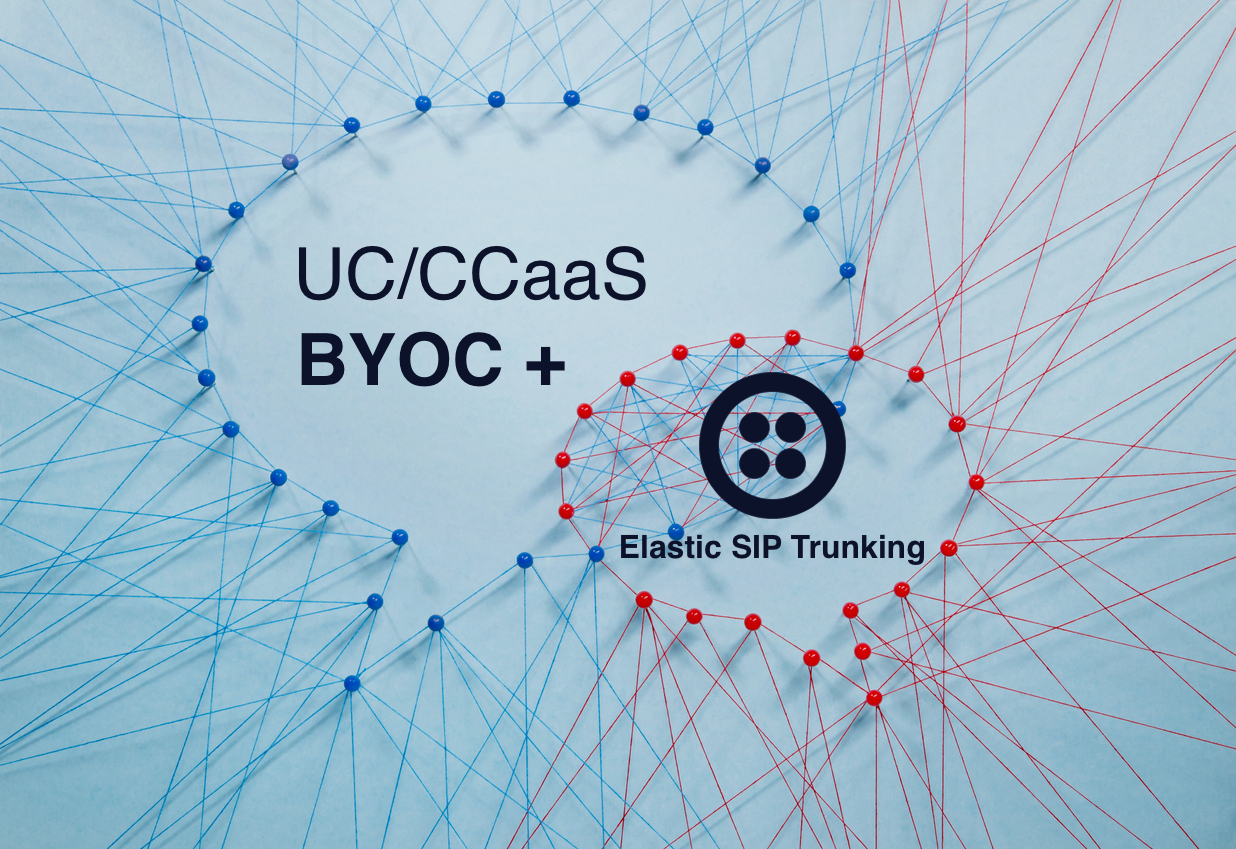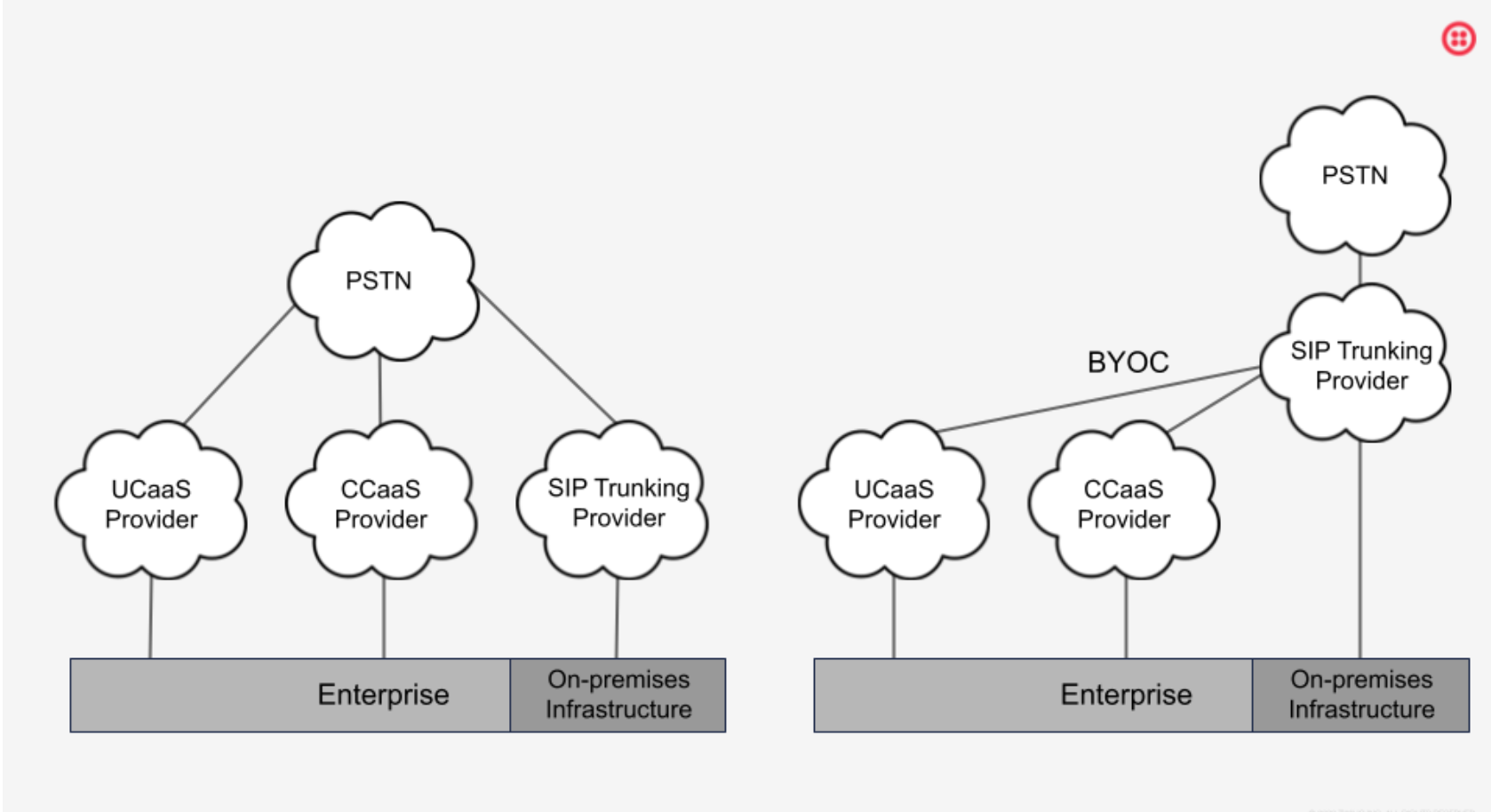BYOC secrets: There is more to SIP trunking than you think
Time to read:

There is a massive wave of enterprises jettisoning their premises-based communications systems in favor cloud-based services. Amidst this scramble, it's easy for Enterprise IT managers to lose sight of an important option available to them. They can connect to the PSTN via their own SIP trunking provider by choosing the bring your own carrier (BYOC) option offered by most major cloud-based unified communications and contact center providers. BYOC is an important alternative to the bundled PSTN connectivity offered by cloud communications vendors that merits close consideration.
A bundled solution is the default option offered by most cloud-based unified communications (UC) and contact center (CC) services and provides the convenience of one-stop shopping. But, when does it make sense to unbundle PSTN connectivity and go with a BYOC solution? This blog carefully examines the factors involved in this decision. We’ll review the tradeoffs so that you can make the best decision for your organization.
Cloud communications - lots of pluses and a caution
Enterprises are migrating their on-premises VoIP/UC and contact center infrastructure to cloud service providers in droves and the global pandemic has accelerated the pace. According to a 2020 Nemertes survey, 34% of businesses have moved to a unified communications as a service (UCaaS) platform, up from 19% in 2019. IDC provides another barometer, estimating the UCaaS industry grew at a brisk 21.2% clip in 2020.
There are many compelling reasons for enterprises to move their communications to the cloud:
- Lower costs - no servers and software to buy and maintain, simplified administration
- Increased features - UCaaS services integrate PSTN calling with conferencing, screen sharing, presence and chat features for internal communications, while contact center services (CCaaS) provide a plethora of AI-driven productivity improvements.
- Support for new use cases - such as remote workers and contact center voicebots.
- Future-proof services - providers are continuously adding new UC and contact center features and capabilities.
For IT managers, perhaps the biggest draw is simplicity. You get one-stop shopping when you move communications to a cloud provider (at worst, it’s two stops when you add a separate contact center service).
Bundled PSTN connectivity for simplicity
One of the ways cloud providers simplify is by bundling PSTN connectivity into their services. They connect each UC user and/or contact center agent to the PSTN. In the case of UCaaS, you pay a flat monthly fee per user that includes a set of features, plus domestic calling. Cloud contact center services charge fees per agent, plus metered telephony fees for all inbound and outbound calls.
Both UC and contact center services allow you to purchase and provision new phone numbers through the same portal used to administer the rest of the service. Behind the scenes, the cloud provider works with regional telecommunications companies to orchestrate PSTN connectivity. It purchases phone numbers in bulk and provisions the SIP trunks needed to serve all its customers.
What are the issues with bundled PSTN connectivity?
The simplicity of bundled PSTN connectivity comes at a price (literally and figuratively), however. IT managers used to managing their own SIP trunks need to be aware of the trade-offs:
- Increased cost - you typically pay more for bundled calling, regardless of whether you choose a flat fee or metered service. For an average user, flat fees are typically higher than you’re spending on legacy metered calling services using on-premises VoIP/UC and a SIP trunk. This is because cloud providers don’t operate their own SIP trunking service. Instead, they purchase SIP trunks from a telecommunications company.
- Geographic coverage - Most cloud communications services offer limited geographic reach. For example, you may be able to purchase DID and toll-free phone numbers in 30 or 40 countries. Emergency location services (e.g. e911) may be limited to an even smaller subset.
- Control - you give up control over how PSTN calls are routed. This limits your ability to make routing changes in response to sudden events, makes migration between your on-premises infrastructure and a cloud provider more complex, and perhaps the biggest drawback is difficulty when you want to change cloud providers sometime in the future.
- Variable quality and reliability - Because cloud providers stitch together their PSTN connectivity services using regional telecommunications companies, the quality and reliability can be highly variable. For example, HD voice may be available in some countries, but not others, and impairments may occur more frequently in certain regions.
- Complexity - your DIDs will be managed by separate providers for each cloud service you use - UC, contact center, etc. This can make changing or reassigning numbers more difficult.
For the small and medium sized enterprises that were early adopters of cloud communications services, these tradeoffs were easy to make. SMEs have relatively small organizations and limited international operations. IT managers were happy to pay more for calling in exchange for lower administrative costs and simplicity. But in order for cloud communications services to become mainstream, these tradeoffs had to be overcome.
Cloud providers respond with BYOC
UCaas and CCaaS providers have introduced bring your own carrier (BYOC), an option that marries their cloud communications service with your preferred SIP trunking service. They recognize that decoupling PSTN connectivity from their application services enables them to focus on their core competency while giving customers freedom to choose calling services from a SIP trunking specialist.
With BYOC, your users enjoy all the rich features provided by a cloud communications service together with high quality, global, low cost PSTN calling provided by a specialist SIP trunking service.
BYOC is widely available
Judging by how quickly cloud service providers have added BYOC support, the option is widely successful. Today, 8 of the 10 leading UC and contact center vendors unbundle their services with a BYOC offering.
| UCaaS | BYOC |
|---|---|
| Microsoft Teams | Yes |
| Zoom Phone | Yes |
| Ringcentral Office | Yes |
| Cisco WebEx Calling | Yes |
| Fuze | Yes |
| CCaaS | BYOC |
|---|---|
| Genesys | Yes |
| Amazon Connect | |
| NICE | Yes |
| Twilio Flex | Yes |
| Talkdesk | Yes |
| Five9 | Yes |
What is BYOC?
Technically speaking, Bring Your Own Carrier is an open telephony interface provided by UCaaS and CCaaS providers that connects to a compatible PSTN service provider, such as the Twilio Elastic SIP Trunking service. It enables the cloud service provider to send and receive PSTN calls using a third party service provider as the conduit. The interface adheres to the IETF Session Initiation Protocol (SIP) and each concurrent telephony session is called a trunk. Thus, the PSTN access provider is known as a SIP trunking service provider.

Bundled PSTN connectivity (left) compared with a BYOC solution (right)
In some cases, you’ll need to route PSTN calls through an enterprise session border controller (E-SBC) that connects the UCaaS and/or CCaaS service to your SIP trunking provider. In other cases, the two cloud services are directly connected.
You purchase and administer DID and toll free phone numbers through your SIP trunking provider. For UCaaS services, the cloud provider maps these numbers to user IDs. CCaaS services map inbound DID and toll free numbers to queues, just like on-premises contact center infrastructure.
What are BYOC pros and cons?
BYOC may not be the best choice for every enterprise. You should carefully weigh the respective pros and cons before making a decision. We’ve listed below some of the key comparison points.
BYOC pros
- Global coverage - Depending upon the SIP trunking provider you choose, you may find DID and toll free numbers are available in more places than your UCaaS or CCaaS provider. For example, Twilio Elastic SIP Trunking offers service in 100 countries.
- Low rates - List prices may be lower, plus consolidated buying power helps you drive a better deal with a specialist SIP trunking provider. You can combine all your contact center, VoIP/UC and other traffic for more buying power than you have when calling services are fragmented across different cloud providers.
- Increased control - Your SIP trunking service provides a layer of abstraction between the PSTN and cloud applications, enabling you to independently manage phone numbers and routing. You can apply routing policies before session hand-off to a UCaaS or CCaaS provider. This enables you to control the experience, including outbound source phone number and inbound routing. Also, you can easily provision and reassign DID and toll free phone numbers among your UCaaS, CCaaS and on-premises infrastructure.
Twilio enables you to apply sophisticated routing logic using TwiML or your own application code. In addition, you have more control over cloud migration with the ability to quickly roll-back service to your on-premises infrastructure, if necessary. - Consistently high quality - A specialist SIP trunking service provider delivers high quality, reliable PSTN calling services, often backed by a service level agreement (SLA). In the case of Twilio Elastic SIP Trunking, calls are routed on our SuperNetwork, which continuously optimizes calls over no less than four redundant routes for the best call quality.
BYOC cons
- Multiple service providers - You’ll need to spend more time and effort to select a SIP trunking provider and administer payments for an additional vendor.
- E-SBC may be required - There may be additional cost and administrative overhead to deploy and operate an E-SBC that connects the cloud communications service to your SIP trunking provider.
Multinational eCommerce firm chooses BYOC
The experience of a large European-based enterprise illustrates the BYOC decision making process. The firm had a patchwork of on-premises VoIP infrastructure and SIP trunking services across 28 offices in 23 countries. Faced with high telephony costs and excessive administrative overhead, it issued an RFP to evaluate its options.
The eCommerce marketing services company defined objectives that included simplification and consolidation of communications services, and cost reduction. It wanted to eliminate telephones and server hardware, along with associated maintenance, and enable its headquarters IT team to centrally manage the service for all 28 offices.
The firm chose Zoom and Twilio as its suppliers. The Zoom Phone UCaaS service was selected in part based on familiarity with the Zoom conferencing service. It chose to pair the service with Twilio Elastic SIP Trunking, giving it a dual vendor solution that reaches all its office locations with consistent quality and centralized manageability.
Months after initial deployment, the IT team remains pleased with the solution. With its centralized control, service was fast and easy to roll out to all employees. In minutes, they can provision phone numbers and trunks in any of their office locations.
Is BYOC right for your organization?
We are excited that cloud communications providers have made the BYOC option so widely available. However, BYOC isn’t appropriate for every organization. There are many tradeoffs to be made. One-stop-shopping is the main draw for a bundled PSTN connectivity solution, while BYOC offers potential economic advantages, greater control and better geographic coverage.
We recommend IT managers carefully consider these two options before beginning their migration to cloud communications services. Like the eCommerce marketing firm, you may find two providers are better than one.
Related Posts
Related Resources
Twilio Docs
From APIs to SDKs to sample apps
API reference documentation, SDKs, helper libraries, quickstarts, and tutorials for your language and platform.
Resource Center
The latest ebooks, industry reports, and webinars
Learn from customer engagement experts to improve your own communication.
Ahoy
Twilio's developer community hub
Best practices, code samples, and inspiration to build communications and digital engagement experiences.

